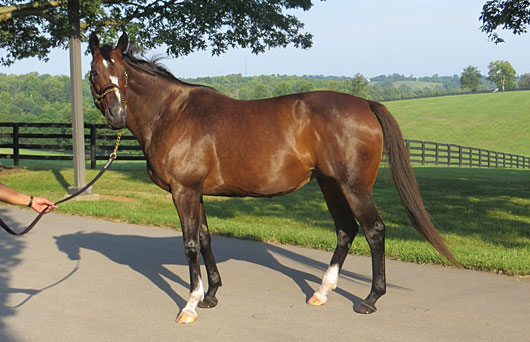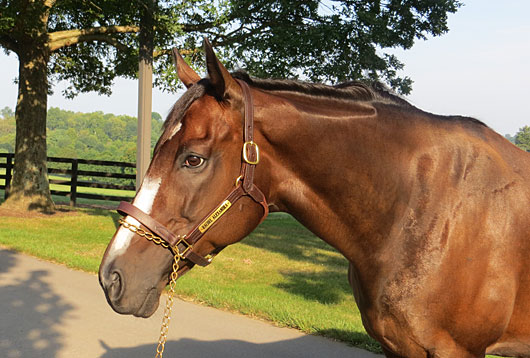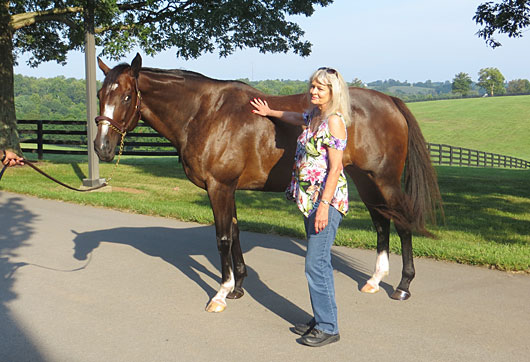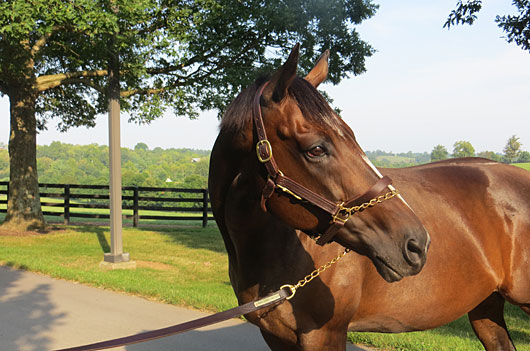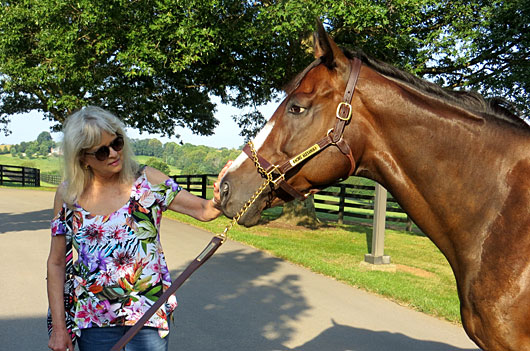Rachel Alexandra was led out of her barn, her coat glistening and dappled and a bit lighter than when she was racing. As she stood placidly in the morning sun, she was not bothered in the slightest by the two visitors fawning over her. She has held her weight extremely well, and she still has that same bright eye her fans remember during her glory days.
It’s been over four years since the racing world prayed for Rachel Alexandra, their prayers inundating social media, as thousands of anguished horse lovers and fans of Rachel expressed their heartfelt feelings for the great mare whose life was in grave danger following surgery to repair her damaged colon suffered after foaling a strapping 140-pound filly.
Thanks to the devotion and perseverance of Brent Comer, a medical technician at Rood & Riddle Veterinary Clinic who now works full-time at Stonestreet, Rachel survived, but it was touch and go for a long time.
The foaling was uneventful, but while being checked out it was discovered she had excessive fluid in the abdomen and needed to have surgery. Rachel had ruptured her colon and had fecal matter in her abdomen. Horses normally don’t survive from that, but Rachel fought through it with the same determination and tenacity she fought her way to victory in the Woodward Stakes four years earlier.
Comer rode with Rachel back to Rood & Riddle and was with her through the entire six-hour surgery. For the next several months he would rarely leave her side. It was at the clinic that Comer met Stonestreet owner Barbara Banke for the first time.
It was close to 1 a.m. when Rachel was taken out of surgery and Comer laid down with her in the stall, along with Dr. Eric Carlson, who was an intern at the farm. They stayed with her until she was able to stand on all four legs. Rachel was kept in a stall near the surgery where they ran fluids on her. Comer stayed with her for 72 hours straight, then sat with her 12 to 14 hours a day, seven days a week, grooming her and walking her every day and administering her medication.
Rachel finally returned to Stonestreet Farm, and as the van turned on Elkchester Road and neared the entrance gate, Comer said she let out a cry as if letting everyone know she was home. It was a moment he will never forget.
It wasn’t until Rachel was back at the farm for two months that it was determined she was out of the woods, because there is always the risk of complications from surgeries of this type. But they had felt it was time for her to get back to the farm where they could take care of her in that setting rather than standing in the same stall all day long.
Rachel had survived her ordeal, and as it turned out, her foal, named Rachel’s Valentina, would go on to win the grade I Spinaway Stakes. Although Rachel likely will never be bred again because of the risk involved, she has passed the torch to her daughter, who is now a broodmare at Stonestreet and is in foal to Curlin. And on Saturday, Rachel’s half-brother, Fayeq, will compete in the historic Travers Stakes. Although a longshot, with only four career starts and two straight victories, he does have a bright future. As Stonestreet broodmare manager Louis Logan said, “It’s exciting to see the family flourishing.”
Now, here was Rachel Alexandra, approaching the eighth anniversary of her amazing victory in the Woodward Stakes, which many believe to be her greatest moment, looking happy, healthy, and seemingly enjoying her new life.
She spends most of her time in a 25-acre field along with two other pensioned mares, with whom she has bonded.
“She’s outside 22 hours a day,” Logan said. “We decided to place her with a couple of retired mares. We thought it would be best for her in the long term to have a stable life instead of putting her out with active broodmares and constantly changing who she’s turned out with. We tried to pick the best looking pensioned mares we had available at the time who would be presentable for all the guests who come to see Rachel. She comes in twice a day to be fed. She stays in her stall for about an hour to an hour and a half, morning and afternoon. The rest of the time she’s out in the field.
“She gets along very well with the two mares (whose names he preferred not to mention) and it appears as if she’s thriving. In fact a couple of times I was worried about her getting over the top a little bit and becoming overweight, but I try to restrain myself from making any adjustments in her feeding program. We’re happy with the how she’s doing, but it was quite a long shot.
Logan said it is Barbara Banke’s decision, but as far as he knows it is safe to assume they won’t breed her again.
As I watched Rachel walk out of the barn looking like a picture and standing so calmly as my wife pet her, while posing for pictures, I couldn’t help but think back to that remarkable 3-year-old campaign in 2009 when she performed feats never before seen by a young filly. And not a Woodward Stakes has gone by since that I don’t think of the day Rachel rocked the Spa like it’s never been rocked before.
I cannot remember a filly winning a race as easily as Rachel won the Kentucky Oaks (by 20 1/4 lengths) and the Mother Goose (by 19 1/4 lengths). In fact, I have never seen any horse, male or female, run so easily and so fast in the same race, as Rachel won the Mother Goose in a common gallop the length of the stretch in a blazing 1:46 1/5 for the mile and an eighth in what can only be described as a mind-blowing performance.
And who can forget her crushing Belmont Stakes winner and eventual Jockey Club Gold Cup winner Summer Bird and the brilliant Munnings in the Haskell Invitational in the slop in 1:47 1/5, just a fifth of a second off the stakes record and two fifths off the track record set by Spend a Buck 24 years earlier.
Of course, there was the Preakness Stakes, where she became the first filly to win the second jewel in the Triple Crown since Nellie Morse in 1924.
But the race that remains embedded in the mind and heart is her courageous victory in the Woodward Stakes, a race that not only gutted her, but every horse who made a run at her. It eventually would take its toll on all of them.
That was the day those old rafters holding up the Saratoga grandstand rocked like they have never rocked before. And for as long as racing fans flock to the Spa in droves each year, that courageous triumph in the Woodward Stakes will remain frozen in time, as will the deafening roar that greeted Rachel Alexandra following her gut-wrenching victory. Racing’s grand old lady had experienced many great moments in 145 years, but never has she been engulfed by such an eruption of sound as she was on this day.
But, as mentioned, it came at a price. The Woodward would claim not only the victor, but those who dared to challenge her. Rachel would go on to win other stakes races at 4, but we would never again see that same grace and devastating power and the sheer joy of running we witnessed in the spring and summer of 2009.
As then 97-year-old racing legend John Nerud pointed out about the Woodward. “They sent two speed horses after her and made her go in :22 4/5, then they came after her one at a time and she put them all away. Those were tough older horses and they tried everything they could to get her beat and they couldn’t. I think she’s the best I’ve ever seen. I don’t compare her to anyone.”
The skeptics will point out that Macho Again and Bullsbay were just ordinary horses, and defeating them did nothing to boost Rachel’s reputation. A good deal of that skepticism was based on what they did, or didn’t do, after the Woodward. What they didn’t realize was that the horses who entered the starting gate to face Rachel in the Woodward were far different than the shattered fragments that remained after they looked Rachel in the eye. Runner-up Macho Again and third-place finisher Bullsbay raced a total of 10 more times and managed only one second-place finish by the latter.
But Macho Again went into the Woodward having won the grade 1 Stephen Foster Handicap and grade 2 New Orleans Handicap and the previous year’s Jim Dandy Stakes and Derby Trial Stakes with rousing stretch runs, and was second in the Preakness and Super Derby. He came into the Woodward off a fast-closing second to Bullsbay in the Whitney, run in a sharp 1:48 flat for the 1 1/8 miles. Bullsbay had finished a close fourth, beaten 1 1/4 lengths, in the Stephen Foster and had won the Alysheba Stakes at Churchill Downs. In the Whitney, his explosive of turn of foot, in which he went from 11 lengths back to the lead, was one of the highlights of the meet.
Also in the Woodward, making a threatening move on the far turn, was Asiatic Boy, the first horse ever to sweep the United Arab Emirates Triple Crown. He also was second in the Dubai World Cup to Curlin, second in the Stephen Foster to Macho Again, finishing ahead of Einstein, and second in the Suburban Handicap. Past the Point, who looked Rachel in the eye after she seemingly had been softened up by Belmont Stakes winner Da’ Tara and Cool Coal Man, had put a scare in Horse of the Year Curlin in the previous year’s Woodward, pulling up to his flank in the stretch, only to be beaten 1 1/4 lengths.
All these horses went into the Woodward coming off a win or a second. All made their moves at Rachel at some point, and none were ever the same. This was a race that gutted Rachel and all those who challenged her. Rachel gave every ounce of her being, turning back one challenge after another in testing fractions, and who knows in the long run how much of her heart spilled out onto the Saratoga track that day.
What made her victory even more impressive was that it was her eighth of the year, at seven different racetracks, and ninth in succession, including the aforementioned victories over the colts in the Preakness and Haskell Invitational.
It was her bravery in battle at the end of one of the most ambitious 3-year-old campaigns by a filly in the history of the sport that truly defined her greatness and set off the wave of emotion that greeted her after the race and the pandemonium that engulfed all those standing on the racetrack.
It was that same bravery that had her trainer, Steve Asmussen, weeping in his wife Julie’s arms, as he buried his head in her embrace. When his oldest son, Keith, said to him, “I’ve never seen you cry at the races,” Asmussen replied, “I never needed to.”
And it was that bravery that had her exercise rider Dominic Terry bawling behind his sunglasses and walking around in a daze, repeating, “She did it…she did it…she did it.” The following morning, he still was “physically and mentally exhausted.”
Noted veterinarian Dr. Mark Cheney said, “You don’t see many horses livin’ that could have won that race.”
Even the vanquished became caught up in the enormity of Rachel’s achievement. “She had everything thrown at her and she overcame it all,” said Graham Motion, trainer of Bullsbay. “I’ve never seen anything like it. You had that feeling of a horse trying for the Triple Crown. It’s the stuff of legends.”
Rachel Alexandra will forever remain a part of Saratoga history. Saratoga mayor Scott T. Johnson proclaimed Sept. 5, 2009 “Rachel Alexandra Day.” Two days before the Woodward, Rachel received a huge ovation when she schooled in the paddock, as a horde of photographers, cameramen, and onlookers followed after her like a pack of paparazzi. All Asmussen could say was, “She’s a deserving diva.”
On race day, fans began lining up to secure their place around the paddock and along the path leading to the paddock several races before the Woodward. As the race approached, the cheers could be heard well off in the distance, signifying Rachel’s imminent arrival.
“I’ve walked over for a lot of big races – the Dubai World Cup, the Triple Crown races, last year’s Woodward,” said assistant Scott Blasi. “I have never felt that kind of adoration for one horse. I’m talking about people 10 deep on both sides walking to the paddock, and all they want to do is get a glimpse of her. If anyone thinks people don’t love horse racing they should have been in my shoes walking to the paddock.”
Asmussen added, “I’ve never seen them lined up like that. It was like a soccer game where everybody is pressed up against each other to get a look. When we walked Curlin over last year it was a big deal, but it wasn’t anything like this. They were three and four deep for Curlin, and they were at least 10 deep just to get a peek at her.”
As the field approached the starting gate, majority owner Jess Jackson took a final sip of his beverage and stared intently at his filly, as his wife, Barbara Banke, held her hand against the side of her face and continuously rocked back and forth in her seat. Several boxes away, an intense Asmussen leaned forward and sat there motionless while Julie clasped her hands together and rested them against her lips. They were well aware that Rachel was only nine furlongs away from entrance into the pantheon of the immortals.
Who can forget track announcer Tom Durkin bellowing after that brutal opening quarter in :22 4/5, “There’ll be no free ride for Rachel Alexandra. They’re making her work for every step today.”
In the stands, Jackson’s bloodstock agent John Moynihan, like many, had a sinking feeling. “I put my program down and put my head in my hands,” he said. “All I could think was, ‘How could this have happened today?”
They came at her one by one – Da’ Tara, Cool Coal Man, Past the Point through a testing three-quarters in 1:10 2/5. Then Bullsbay pulled up to her flank before Asiatic Bid and finally Macho Again moved in for the kill, expecting to encounter a softened up Rachel in the final furlong.
Rachel was set down by Calvin Borel, who hit her five times right-handed and then three times left-handed. She turned back Bullsbay’s challenge, but here came a fresh Macho Again, who had found a gaping hole at the top of the stretch. The charging gray stormed up alongside Rachel, who was now being barraged with a series of 13 desperate right-handed whips from Borel. Macho Again kept coming, but Rachel kept finding more. The crowd urged Rachel to hold on, their hearts pounding with every stride.
Rachel continued to dig in and would not let Macho Again get by. This was a filly who had won almost all her races eased up with her ears pricked, never feeling to sting of the whip. Now she had her ears pinned and was under a salvo of left and right-handed whips by a frantic Borel. Rachel would not be denied, hitting the wire a head in front. The place went crazy. Despite her early efforts, she still was able to close her final eighth in a respectable :12 4/5 to complete the 1 1/8 miles in 1:48 1/5, earning a 109 Beyer speed figure – this coming after a grueling campaign that saw her run a 108 Beyer in the Kentucky Oaks, a 108 in the Preakness, a 111 in the Mother Goose, and a monster 116 in the Haskell Invitational.
Rachel’s time still was the fastest Woodward in the seven years it had been run at Saratoga – faster than Curlin, Quality Road, Lawyer Ron, Havre de Grace, Premium Tap, and To Honor and Serve.
Rachel returned to a deafening ovation, which reached a crescendo when a jubilant Borel led the daughter of Medaglia d’Oro into the winner’s circle. After the photo, Borel draped the blanket of pink carnations over his shoulder and dismounted.
Rachel Alexandra had become the first filly to win the Woodward. The last 3-year-old filly to even run in the race was Summer Guest in 1972. No 3-year-old filly had ever defeated older males in a two-turn, grade I dirt race. The last to win a major two-turn dirt stakes over her elders was Misty Morn in the 1955 Gallant Fox Handicap.
As Rachel was led back to the barn and the crowd began to quiet down, Durkin announced, “Well, folks, if your heart can take it, we’ve got two more races.”
Jackson, who owned Rachel in partnership with Harold McCormick, summed it up best: “I think she’s something for the ages. The 56th running of the Woodward was a great one for the history books, and I’m so pleased for her. For her to hang in there like that with six giant males racing with her was something special.”
Asmussen said the early fractions “may have taken a few years off my life but it was probably worth it.” As he walked, he was able to reflect a bit more on what Rachel had achieved: “It’s hard enough to be brilliant once in a while, but every race? Oh, my God, she’s been doing it since mid-February. She showed she’s truly a champion today. I get nervous, I admit it. I wouldn’t go downstairs until they put her number up; that’s me.”
As Rachel left the test barn and crossed Union Ave. to the Oklahoma training track, the halted traffic was already backed up and a few lucky fans in the front cars were able to get a final look at Rachel as she headed home.
Back at the barn, Rachel was put away for the night, picking away at her alfalfa and occasionally eyeing all the activity outside the barn.
As he was about to leave for dinner, Jess Jackson said, “There’s an aura around her, isn’t there? It was quite a day. I think I’ll have a double scotch tonight.”
As darkness fell, assistant trainer Blasi tried to put everything in perspective. “She’s absolutely unbelievable,” he said. “There’s no comparing her to anyone. They all compare to her now. What she did today, you will never see anything like it again.”
To summarize Rachel’s amazing year, in 2009 she:
Defeated eight Derby winners (Kentucky Derby, Santa Anita Derby, Arkansas Derby, Louisiana Derby, Illinois Derby, Tampa Bay Derby, Iowa Derby, and UAE Derby), plus the runner-up in the West Virginia Derby.
Defeated eight grade I-winning males, including the winners of the Belmont Stakes (twice), Travers, Jockey Club Gold Cup, Whitney, Stephen Foster, Blue Grass, and Secretariat Stakes, as well as the winners of the Oaklawn Handicap, New Orleans Handicap, Jim Dandy Stakes, Tom Fool Handicap. Woody Stephens Stakes, and Lone Star Handicap.
Became the first filly to defeat three classic-winning males, and defeated the 1-2-3 finishers of the Kentucky Derby, the 1-2 finishers of the Whitney, the 1-2 finishers of the Stephen Foster, and the 1-3 finishers of the Belmont Stakes.
Her last six victories in 2009 all had historical significance.
Fantasy Stakes -- Biggest margin in the history of the race (8 3/4 lengths).
Kentucky Oaks -- Biggest margin in the history of the race (20 1/4 lengths).
Preakness -- First filly to win the Preakness in 85 years and the first horse in history to win from post 13.
Mother Goose -- Biggest margin in the history of the race (19 1/4 lengths), previously held by Ruffian, and ran the fastest time in the history of the race (1:46 1/5).
Haskell – To repeat, second biggest margin in the history of the race (six lengths), and second fastest time (1:47 1/5) in the history of the race by one fifth of a second, and two fifths of a second off the track record set by Spend a Buck 24 years earlier.
Woodward -- First filly in history to win the Woodward, and ran the fastest time since the race was moved to Saratoga.
Even winning the Woodward by a head and the Preakness by one length, Rachel’s average margin of victory in 2009 was an astounding 8 1/4 lengths.
No one will ever know for sure what toll the Woodward took on her. There is no doubt she was not the same horse in 2010, and there is no denying the fact that, although she remained in Asmussen’s barn over the winter, she did not have a single work in five months.
We can only speculate just how much of her she left on the track that day. But there’s one thing that is certain. She left behind a moment in history.
That moment was crystal clear as we bid farewell to Rachel and drove out of Stonestreet Farm. We had seen true greatness – a filly whose spectacular moments on the racetrack were overshadowed by her will to win and her will to live. It was now a little past 9:30 a.m. Not a bad way to start the day.
